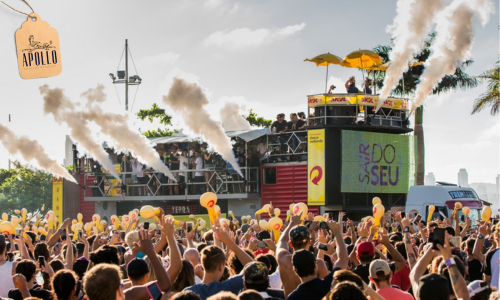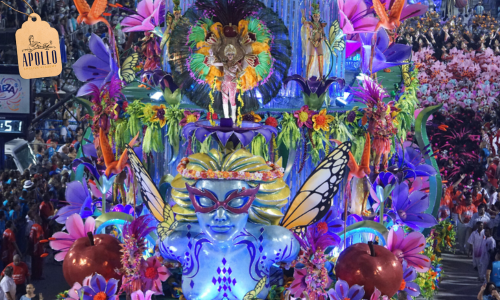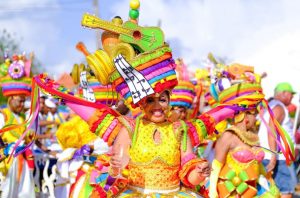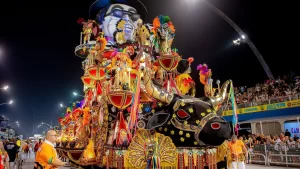Introdução
O Carnaval (carnival) no Brasil é mais do que uma simples festa — é uma experiência cultural única que transforma cidades inteiras em um verdadeiro espetáculo de cores, ritmos e alegria. 🎭✨ Durante essa celebração, milhões de pessoas se reúnem para dançar, cantar e viver momentos inesquecíveis ao som do samba, do axé e de tantos outros ritmos que fazem parte da identidade brasileira. Mas você sabia que o Carnaval não acontece da mesma forma em todo o país?
Enquanto no Carnaval do Rio de Janeiro os desfiles das escolas de samba encantam com figurinos luxuosos e coreografias ensaiadas, no Carnaval de Salvador, o trio elétrico domina as ruas e a festa acontece de maneira mais espontânea e interativa. Seja você fã de grandes espetáculos ou de uma folia sem regras, o Carnaval no Brasil tem algo especial para todo mundo!
Neste artigo, vamos explorar as diferenças entre essas duas versões icônicas do Carnaval, ajudando você a decidir qual delas combina mais com o seu estilo. Então, separe sua fantasia e entre no clima da maior festa do planeta! 🎶🔥
📖 Aqui você encontra…
clique para verNível:
B1 (Intermediário)
Objetivo:
Expandir o vocabulário relacionado a Carnaval, cultura brasileira e festividades, além de aprender sobre as diferenças entre o Carnaval do Rio de Janeiro e de Salvador.
Tópicos gramaticais abordados nesse texto:
- Simple Present: Para descrever fatos gerais, como em “Carnival is one of the most vibrant celebrations in the world.”
- Comparatives and Superlatives: Para contrastar diferentes estilos de Carnaval, como em “Rio’s Carnival is more organized, while Salvador’s is wilder.”
- Passive Voice: Para enfatizar a ação, como em “Each school is judged based on their performance.”
- Relative Clauses: Para adicionar informações sobre substantivos, como em “The trio elétrico, which is a massive sound truck, leads the party.”
- Expressions of Time: Como “every year,” “at sunrise,” e “through the streets”, que situam os eventos no tempo.
Carnival in Brazil: A Celebration Like No Other
Brazil is home to one of the most vibrant and diverse cultural celebrations in the world: Carnival! This world-famous festival is a time of music, dance, and pure joy, bringing millions of people together in a vibrant explosion of colors and culture. But did you know that Carnival is celebrated differently depending on where you are in Brazil?
Today, we’re diving into the two most famous Carnival celebrations: Rio de Janeiro and Salvador. Get ready to discover what makes each of them unique and why Brazil’s biggest party is an experience you must-have at least once in your life!
Carnival in Rio de Janeiro: The World’s Biggest Show
Rio de Janeiro’s Carnival is nothing short of spectacular. Often called “The Greatest Show on Earth,” it features extravagant samba parades, dazzling costumes, and breathtaking performances at the Sambadrome, where the city’s top samba schools compete for the grand title.
Each school spends the entire year preparing for this moment, crafting massive floats, designing stunning outfits, and rehearsing complex choreography. The energy in the air is electrifying — thousands of dancers, percussionists, and singers fill the streets, making sure every step and beat is flawless.
But Carnival in Rio isn’t just about the parades. The “blocos de rua” (street parties) turn the entire city into a dance floor! Anyone can join, and each bloco has its own theme, music, and crowd. Whether you want to dress up as your favorite character, dance to samba until sunrise, or simply soak up the incredible atmosphere, Rio has a bloco for you.
Carnival in Salvador: The Ultimate Street Party
While Rio’s Carnival is known for its elegance and precision, Salvador’s Carnival is all about raw energy and pure fun! Instead of samba, here the rhythm is axé, an upbeat and irresistible musical style that blends African and Brazilian influences.
And what is the highlight? The trio elétrico — huge sound trucks that drive through the streets with famous musicians performing live on top. The crowd, known as the “pipoca”, follows along, dancing and singing in the ultimate street party. Unlike Rio’s organized parades, Salvador’s Carnival is all about movement, interaction, and non-stop celebration.
There are three main ways to enjoy it:
-
Camarotes – Exclusive areas with great views, drinks, and VIP service.
-
Blocos – Groups that follow a specific trio elétrico, usually wearing matching shirts.
-
Pipoca – Free-spirited revelers who join the party without restrictions!
No matter how you choose to celebrate, one thing is guaranteed: Salvador’s Carnival is a once-in-a-lifetime experience that will leave you breathless (and probably without a voice from all the singing)!
Which Carnival is Right for You?
If you love organized parades, spectacular costumes, and samba, then Rio de Janeiro is your perfect match. But if you prefer a wild, high-energy, immersive street party, then Salvador is the place to be.
Of course, why choose just one? Many people dream of experiencing both and living the full Brazilian Carnival adventure!
Get Ready for Carnival — And for Speaking English Like a Pro!
Carnival is all about connecting with people, and what better way to do that than by improving your English? Whether you’re planning to visit Brazil during Carnival or just want to talk about it with friends from around the world, speaking English can open doors to amazing conversations and experiences.
Want to take your English to the next level? Talk to us today and start your journey!
Are You a Trio Elétrico or a Carro Alegórico? 🎭
What’s your ideal weekend plan?

How many friends do you have?

What’s your favorite kind of music?

How do you feel about attention?

What’s your ideal beach day?

What’s your food vibe?

What’s your biggest strength?

How do you dance at a party?

How do you handle problems?

What do people say about you?








